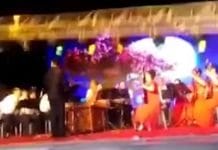
Hey, wanna see something ridiculously beautiful?
This image is of a really young star cluster called R136 – scientists think that it’s only a couple of million years old (you know, only), and lives inside the 30 Doradus Nebula. You know, the 30 Doradus Nebula. Yeah, I really have no idea where that is either – but it’s a very violent, turbulent region inside of the Large Magellanic Cloud. See the blue dots? Those are some of the largest stars known – some over hundreds of times larger than our Sun.
The Hubble Telescope’s Widefield Camera 3 took the above image in red, UV, and visible light. This blew my mind – that image is about 100 light years wide. The green hue in the photo is the glow of oxygen; red from fluorescing hydrogen; the blue hues are the hottest and largest stars. It just blows my mind – the swirling cream-colored masses, it’s like space mist, so intangible to my imagination.
From the NASA site on this image:
The brilliant stars are carving deep cavities in the surrounding material by unleashing a torrent of ultraviolet light, and hurricane-force stellar winds (streams of charged particles), which are etching away the enveloping hydrogen gas cloud in which the stars were born. The image reveals a fantasy landscape of pillars, ridges, and valleys, as well as a dark region in the center that roughly looks like the outline of a holiday tree. Besides sculpting the gaseous terrain, the brilliant stars can also help create a successive generation of offspring. When the winds hit dense walls of gas, they create shocks, which may be generating a new wave of star birth.
The movement of the LMC around the Milky Way may have triggered the massive cluster’s formation in several ways. The gravitational tug of the Milky Way and the companion Small Magellanic Cloud may have compressed gas in the LMC. Also, the pressure resulting from the LMC plowing through the Milky Way’s halo may have compressed gas in the satellite. The cluster is a rare, nearby example of the many super star clusters that formed in the distant, early universe, when star birth and galaxy interactions were more frequent. Previous Hubble observations have shown astronomers that super star clusters in faraway galaxies are ubiquitous.
Beautiful. Ridiculously beautiful.





